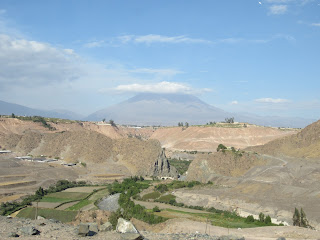So said Italian Naturalist Antonio Raimondo in the 19th
century and it’s sometimes how they describe themselves. Their pre Colombian use for gold was to create purely
decorative items, it had no other use as it was too soft; ditto goes for
silver. Mining, however, is a very much
part of their existing economy although as tourists we see only the periphery of
it.
We travelled from the port of Matarani to Peru’s second
largest city Arequipa along the Pan American highway across parts of the Atacama
Desert, the driest place on earth. They
get about 200 mms of rain every 30 years at a best estimate, but most of that
is in fact dew so it’s probably less than that.
 |
| Atacame Desert, Pan American Hwy Peru |
It’s a rather hairy trip so I was glad Paul had the window
seat. I've seen ‘The Wages of Fear’ and
many of the trucks we passed had ‘Combustibles’ written in big letters and road
is littered with roadside memorials to travelers killed on the road. This year the remodeled Paris to Dakar rally was actually held from Lima to Santiago and some of this of road was included.
 |
| Mining and Irrigation change the landscapr |
There was plenty of evidence of mining and also of squatters
who set up ‘humpies’ and then demand water and power and then on sell
them. Our tour guide was somewhat
disparaging about this black market behaviour.
 |
| Pan American Highway |
We went to Arequipa in the main to see the Convent of Santa
Catalina not opened to the public until 1970 although it had been operating
(and still does) as a nunnery since 1579.
 |
| Santa Catalina convent - detail |
The old city has a (another!?) UNESCO heritage listing from 2000, and
the city is very proud of its literary heritage culminating with the endowment
of a Nobel Laureate for Jorge Mario Pedro Vargas Llosa in 2010.
 |
| Arequipa at night |
It is known as the White City not because its buildings are
white (and they are), but because for many generations the Spanish did not
intermarry and this kept the population up to 80% ‘white’. Now, like most of Peru the population is mestizos of mixed race. It’s 2330 metres above sea level and
surrounded by snow-capped volcanoes – it only snows in summer as there’s no moisture
in winter for the snow to fall. It is
situated on the Chili River which means ‘cold’ as it flows from the Andes.
 |
| Volcano from Santa Catalina Monastery |
It is also the centre of textile manufacturing for the very
rare vicuna (scarf $800, coat $8,000), baby alpaca and Guanaco. Chanel and Armani come here to supervise the
manufacture of the cloth for their finest suits. I passed on this, but did buy a rather nice
pair of earrings.
We’re now on our way to Chile – what fun!!
J'aimerais visiter le désert Atacame, sonne comme l'endroit idéal pour prendre un plein Esky des bières fraîches, crème solaire, vêtements sensibles (comme le Panama) prennent un téléphone, appelez la famille de Bill et regardez-les d'atterrissage.
ReplyDeleteHey aquanowt, I hope Bill's friends dont experiment on you, he has a evil grin ...
ReplyDeletepeDoghQo
ReplyDelete